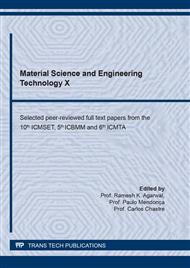[1]
S. C. Cripps. Advanced techniques in RF power amplifier design (Artech House, Norwood, MA, 2002).
Google Scholar
[2]
A. Pressman, K. Billings, and T. Morey. Switching power supply design (3rd Ed., Mcgraw-hill, 2009).
Google Scholar
[3]
A. Eroglu. Introduction to RF power amplifier design and simulation (CRC Press, Taylor & Francis, USA 2016).
Google Scholar
[4]
M. Isaksson, D. Wisell, and D. Ronnow. A comparative analysis of behavioral models for RF power amplifiers. IEEE Trans. on Microwave Theory and Techniques. Vol. 54(1) (2006) p.348 – 359.
DOI: 10.1109/tmtt.2005.860500
Google Scholar
[5]
L.A. Samoska. An overview of solid-state integrated circuit amplifiers in the submillimeter-wave and THz regime. IEEE Trans. on Terahertz Science and Tech. Vol. 1(1) (2011) pp.9-24.
DOI: 10.1109/tthz.2011.2159558
Google Scholar
[6]
V. M. Srivastava, K. S. Yadav, and G. Singh. Design and performance analysis of double-gate MOSFET over single-gate MOSFET for RF switch. Microelectronics J., Vol. 42(3) (2011) pp.527-534.
DOI: 10.1016/j.mejo.2010.12.007
Google Scholar
[7]
F. H. Raab, P. Asbeck, S. Cripps, P. B. Kenington, Z. B. Popovic, N. Pothecary, J. F. Sevic, and N. O. Sokal. Power amplifiers and transmitters for RF and microwave. IEEE Trans. on Microwave Theory and Techniques. Vol. 50(3) (2002) pp.8-24.
DOI: 10.1109/22.989965
Google Scholar
[8]
S. H. Mbonane and V. M. Srivastava. Class-B power amplifier with double-gate MOSFET: A circuit perspective. 5th Int. Conf. on Materials Sciences and Nanomaterials, London, UK (2021).
DOI: 10.4028/www.scientific.net/kem.907.50
Google Scholar
[9]
B. Cordell: Designing audio power amplifiers (1st Ed., McGraw Hill, 2010).
Google Scholar
[10]
N. O. Sokal. RF power amplifiers, classes A through S - How they operate, and when to use each. Professional Program Proceedings, Electronic Industries Forum of New England, Boston, USA, (1997) pp.179-252.
DOI: 10.1109/eif.1997.605386
Google Scholar
[11]
A. S. Sedra and K. C. Smith: Microelectronic circuits: Theory and applications, (7th Ed., Oxford University Press, USA 2014).
Google Scholar
[12]
J. C. Pedro, L. C. Nunes, and P. M. Cabral. A simple method to estimate the output power and efficiency load-pull contours of class-B power amplifiers, IEEE Trans. on Microwave Theory and Techniques, Vol. 63(4) (2015), pp.1239-1249.
DOI: 10.1109/tmtt.2015.2403318
Google Scholar
[13]
V. M. Srivastava and G. Singh. MOSFET technologies for double-pole four throw radio frequency switch, (Springer International Publishing, Switzerland, Oct. 2013).
DOI: 10.1007/978-3-319-01165-3_4
Google Scholar
[14]
G. R. Walker. A class B switch-mode assisted linear amplifier. IEEE Trans. on Power Electronics. vol. 18(6) (2003), p.1278 – 1285.
DOI: 10.1109/tpel.2003.818825
Google Scholar
[15]
M. Hayati, A. Lotfi, M. K. Kazimierczuk, and H. Sekiya. Analysis and design of class-E power amplifier with MOSFET parasitic linear and nonlinear capacitances at any duty ratio. IEEE Trans. on Power Electronics. Vol. 28(11) (2013) pp.5222-5232.
DOI: 10.1109/tpel.2013.2247633
Google Scholar
[16]
S. Pillay and V. M. Srivastava. Realization with fabrication of double-gate MOSFET based class-AB amplifier. Int. J. of Electrical and Electronic Engineering & Telecommunications. Vol. 9(6) (2009), pp.399-408.
DOI: 10.18178/ijeetc.9.6.399-408
Google Scholar
[17]
J. H. Jeong, G. H. Kim, B. R. Min, C. H. Ahn, and G. H. Cho. A high efficiency class A amplifier accompanied by class D switching amplifier. 28th Annual IEEE Power Electronics Specialists Conf., St. Louis, MO, USA, (1997) pp.1210-1216.
DOI: 10.1109/pesc.1997.616906
Google Scholar
[18]
H. Choi. Class-C linearized amplifier for portable ultrasound instruments. Sensors, Vol. 19(4) (2019) pp.1-13.
Google Scholar


